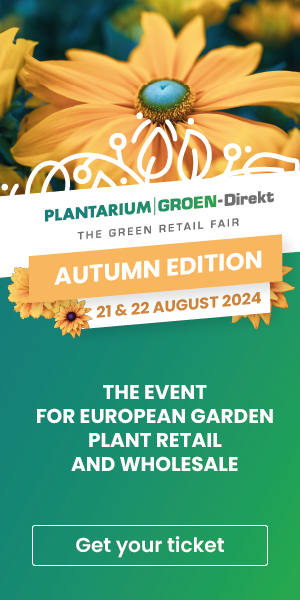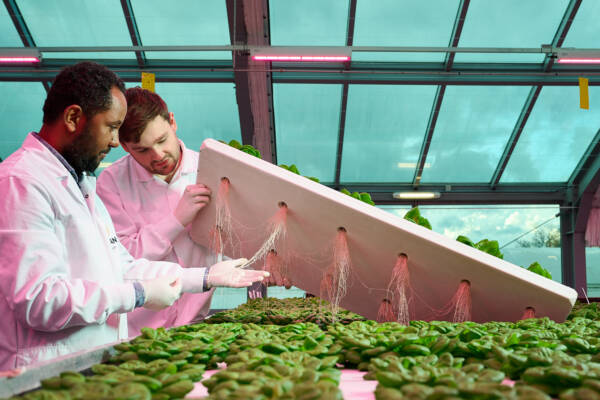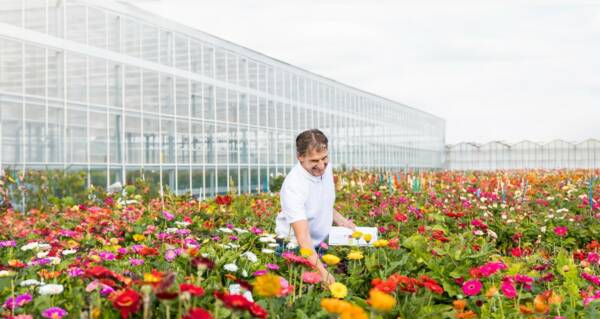Each stage of garden rose production is key in creating a premium quality end product: ‘Eglantine’, ‘Abbaye de Cluny’, ‘Albéric Barbier’, ‘Queen of Hearts’ and ‘Winchester Cathedral’ and many others have come a long, laborious way before ending up in a consumer’s garden.
One can’t help feeling infinite respect for Neyt van Sante Quality Rose bvba, a 28 ha family owned nursery dedicated exclusively to growing roses for the garden. For all the romance and beauty surrounding the queen of flowers, outside on the windy rose fields in Eernegem there is a less rosy reality. Especially when it’s the end of October when the roses are dormant and the first autumn storms sweep the country. It’s the moment hundreds of thousands of thorny bushes must be lifted from the muddy ground to sell as bare root plants or container roses.
Not to mention summer when budders roll up their sleeves to bud each rose by hand. That job requires a strong back and special skills. “If you asked me about future challenges for our business, I would predict that this kind of specialist handwork is at risk of disappearing altogether. We are still lucky enough to work with seasonal rose budding teams from Eastern Europe. But each year it gets harder to find people with prior experience bud grafting rose bushes,” said company owner Patrick Neyt when passionately summing up all the ins and outs of his job.
Soil matters
Neyt van Sante Quality Rose bvba grows nothing else but roses. “It depends how you perceive this as we plant cover crops on half of the land. Tagetes patula and Avena sativa, for example, are planted for the purpose of adding organic matter to our soil. Soil matters more than you think.”
The soil in Eernegem is a combination of sand, clay and loam and -as such- ideal for rose growing. “We apply just the right amount of fertilizer every three to four weeks and generally speaking there is no need to water the plants. Last year was an exception when we had to pump 80m3 water/hour from a nearby pond and used a tractor and tank to water the fields. Crop protection products are hardly needed the first year of production. Diminishing herbicide options, fear of groundwater contamination and customer pressure to minimise herbicide use pushed the company away from reliance on herbicides. We control weeds mechanically most of the time, and if we plan to use herbicides, we make sure to target the weed and no other more valuable species. When controlling weeds we have also deligned a watercourse protection zone,” explained Neyt.
The sea is only 25 km from Neyt’s nursery. “We benefit from a marine climate with mostly mild winters and relatively cool summers. However, over the past 25 years the climate has become more extreme. On the upside the wind blows almost continuously. That’s why we leave 80cm between rows which helps the crops stay dry and healthy. It also helps the roses by making more efficient use of light in the fields.”
Constant cycle
Many years of knowledge and expertise go into creating the perfect garden rose. Like all good things, quality roses take time. “Two years to be more precise,” said Neyt. “We start in April when one year-old seedlings of vigorously-growing Rosa laxa (sourced from Poland and Holland’s northern province of Groningen) are planted in fresh rose fields. The following two months we allow the rootstock plenty of time to become established. The budding mainly takes place in mid-summer (July and August). First, bud wood is harvested from last season’s plants. What follows is T-budding, a job that requires meticulous attention to detail: a budding knife is used to insert a bud of the chosen variety into the neck of each rootstock. As bud unions are sensitive to dirt and winter cold, they are covered with a protective tie immediately after completing the budding process.
Over the next few months the bud grows into a bush and lives off the rootstock’s roots. In January of the following year, hard pruning is used. Canes are cut back to 10 cm which builds up a strong root system and encourages the plant to produce new strong shoots from the bud union. In late spring, the new shoots are cut back moderately to create a bushier plant. Almost all varieties bloom in their first summer providing bud wood for the next generation crop. “As a result we always have two crops of roses underway, creating a constant cycle,” outlined Neyt.
Bare root versus container roses
In September, roses are automatically pruned to 60 cm and in late October another type of machinery gets into the fields and digs up 15,000 to 20,000 rose plants/day. Plants are pruned back hard, tied and labelled. This goes on throughout the winter. “Our sales season runs from October to the end of April of the following year. Half of the roses are sold as bare root plants. The remainder are automatically potted into 3 liter containers for early spring sales. The container stock is potted just before they are trucked to wholesalers, garden centres, landscapers and garden designers with a large portion destined for export sales to France, Switzerland, Austria, Italy, Spain, Scandinavia, Estonia, Poland, Croatia, the Middle East and Russia.
Cream of crop
Neyt-Van Sante supplies over 300 varieties and produces over 500,000 plants a year. The company portfolio includes a wide variety of roses including ground covers, shrub roses, climbers, ramblers and antique ‘heirloom’ garden roses. “We take great pride in being one of the selected rose growers in Belgium to hold special David Austin, Lens, Kordes, Meilland, Tantau and Lens growers license which allows us to grow and sell the cream of the crop. Also, each potted rose is supplied with an attractive coloured label with a picture and description of the rose. It’s one of the tactics to increase impulse buys among shoppers.”











































